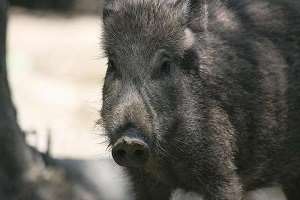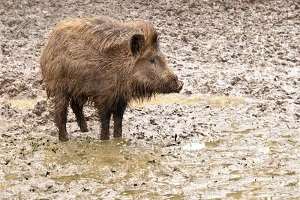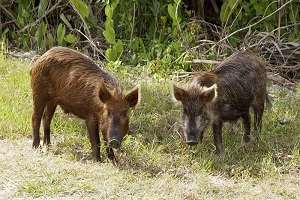By Mary Bates
They go by many names: wild boar, wild hog, razorback, Eurasian boar, feral swine. But whatever you call them, invasive wild pigs (Sus scrofa) are wreaking environmental havoc and spreading rapidly.

Wild pigs were first brought to the southern U.S. in the 1500s as a source of food for early explorers and settlers, and repeated introductions occurred thereafter. In the 1900s, the Eurasian or Russian wild boar was introduced to the U.S. for sport hunting. Today's invasive wild pigs are the descendents of introduced wild boar, escaped domestic pigs, and hybrids of the two.
Gail Keirn, a public affairs specialist at the USDA-APHIS-WS National Wildlife Research Center, says population estimates for the number of feral swine in the continental U.S. vary, but there are likely between 5 and 6 million invasive wild pigs in at least 35 states.
Since 2004, invasive wild pigs have been moving northward at an alarming pace. In addition, the invaders began spreading throughout regions of Canada in 1982 and are threatening to expand their range into the U.S. from the north.
Invasive wild pigs' success can largely be attributed to their lack of natural predators, impressive fertility, adaptability to a variety of climates and conditions, and tendency to eat almost anything. But humans have also helped these invaders spread: both unintentional and intentional releases from farms and hunting preserves, as well as illegal translocation of pigs to create recreational hunting opportunities, has contributed to invasive wild pigs' recent range expansion.

Wild pigs are destructive, costing the U.S. an estimated $1.5 billion each year in damages and control costs.
"Feral swine cause major damage to property, agriculture (crops and livestock), native species and ecosystems, and cultural and historic resources," says Keirn. "This invasive species also threatens the health of people, wildlife, pets, and other domestic animals. As feral swine populations continue to expand across the country, these damages, costs, and risks will only keep rising."
This Little Piggy Went North
The continental U.S. is threatened by the rapid expansion of invasive wild pigs. A better understanding of the factors influencing their spread is needed to predict when and where they are most likely to spread next and develop anti-invasion strategies.
To predict their future spread, Nathan Snow and his colleagues at the USDA National Wildlife Research Center modeled the distribution of invasive wild pigs in the continental U.S. from 1982 to 2012. The researchers looked at factors such as landscape, climate, human presence, and biodiversity on the spread of wild pigs during this time period, and used the model to predict where the pigs are likely to spread next.

Snow and his colleagues found that, during this period, the rate of northward expansion accelerated from 6.5 km/yr to 12.6 km/yr. If this trend persists, invasive wild pigs are predicted to reach most U.S. counties in 30-50 years, but likely faster if a southward expansion from Canada continues.
The results of the model showed that invasive wild pigs are most likely to expand their range into adjacent areas that are similar to the ones they currently occupy. However, the most notable exception was the tendency for wild pigs to spread into areas with colder winters, reflecting their expansion northward. Climate change may be facilitating the spread of invasive wild pigs to northern regions by causing milder winters with less snow. Milder, less snowy winters may make it easier for pigs to find food and survive.
Click here to see more...